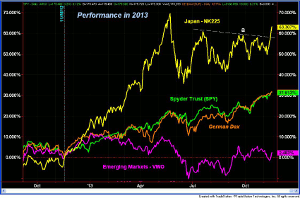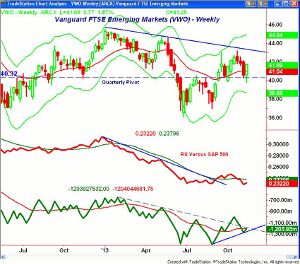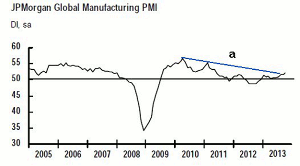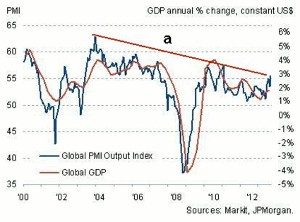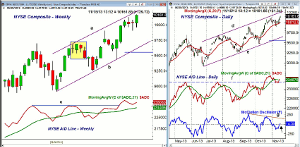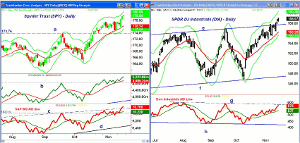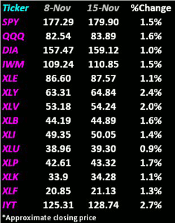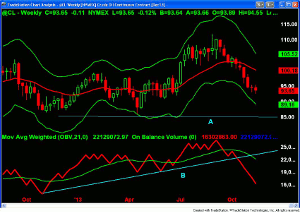Even as the US stock market climbs higher into the "nosebleed zone" and it remains his favorite, MoneyShow's Tom Aspray thinks that the place to be in 2014 will be overseas markets.
It was another week where the stock market surprised the majority by continuing higher despite the already lofty levels of the major averages. The S&P 500 broke through short-term resistance on Wednesday and closed the week just below the 1800 level.
Oftentimes, there is selling when a market average reaches a round number like 1800 but it is also possible this time that a strong close above this level will move more money off the sidelines. Mutual fund managers have a relatively high level of cash on hand and many are not keeping pace with their benchmarks. A failure to match or exceed the benchmarks could jeopardize their year-end bonuses.
Many continue to voice concern over the high level of bullish sentiment, which implies that the smaller investors have joined the party. But Charles Schwab CEO Walter Bettinger commented on CNBC that only about half of their clients think it is a good time to be investing in equities. Furthermore he said "Our clients are engaged, but they're very cautious about the markets overall."
In last week's column, I shared the reasons why I did not think a bubble was forming even though the market is overextended. This is especially true when you look at the investing public as most are now scared to death of the stock market, unlike 2000.
Just a year ago the stock market was bottoming after the post election correction as the S&P hit a low of 1343.65 on November 16. This date it labeled on the chart and shows that one of the star performers since that low has been Japan's NK225, which is up over 63%.
The chart of the NK225 shows that resistance at line a has just been overcome even though some are having doubts about their economic plan. From a technical standpoint, it was clear in early 2013 that both the NK225 and Japanese yen had undergone long-term trend changes that should last many years. This is still my view.
The Spyder Trust (SPY) and German DAX show very similar patters as both are up over 31%, just half of Japan's gain. The emerging markets as measured by Vanguard FTSE Emerging Market (VWO) is now up 2.3% since the November 2012 lows. Since I do feel a more meaningful correction is likely in the next few months (see What to Watch), it should present a buying opportunity. But should you just concentrate on stocks in the US or should you also look elsewhere?
The Vanguard FTSE Emerging Market (VWO) was discussed in more detail in last August's A Contrary Bet for 2014? as I though it might be a star performer in 2014 and advised a dollar cost averaging strategy to get invested. As it turned out, VWO bottomed the following week and had a nice rally into the late October high, but then dropped as many turned became skeptical of the group.
The weekly chart of VWO shows that it may finally be ready to move significantly higher as last week it dropped below its quarterly pivot at $40.32 before closing higher. The OBV had broken its major downtrend in early October and has turned up this week.
Part of my rationale for looking at the emerging markets was that I thought that the US and Eurozone economies were actually doing much better This growth, I felt, should spread to the emerging market economies in the coming year.
Argentina and Dubai have been the two top performers in 2013, up 86.4% and 72.6% respectively, with the US just below Greece on the list. This would have been tough to predict at the start of the year as the wide range of data gives you the ability to predict the US market's direction. Though a sharp correction is possible before the end of the year, we should finish the year with the double-digit gains I was looking for last December.
Though there has been some softness in the recent economic data for the Eurozone lately, which their rate cut may offset, their economies seem to be in an improving trend. The JP Morgan Global Manufacturing PMIT rose to 52.1 in October, which was a 2?-year high.
In an early November press release they stated "The data signaled expansions in the US, the euro area, China , Japan, the UK, South Korea, Taiwan, Canada, Russia, and Brazil." Of course Russia and Brazil have two of the worst-performing stock markets this year, down 5.8% and 15% respectively.
NEXT PAGE: What to Watch
|pagebreak|
The Global PMI Output Index from Markit points to 1.9% global year-to-year GDP in the 3rd quarter, up from 1.1%. Their chart shows the sharp upturn in their Global PMI Index, which is now very close to its downtrend, line a. It does show a pattern of higher highs but the global GDP does not.
The data on the US economy last week was generally weak as the Empire State Manufacturing Survey dropped into negative territory. Imports also were down sharply due in part to a contraction in petroleum-based products. The Industrial Production also slipped to -0.1% but the manufacturing sector component did show nice growth.
On Monday, we get the monthly Housing Market Index, followed by more housing data on Wednesday with Existing Home Sales. The homebuilders bounced late last week and finally show some signs of bottoming.
The Employment Cost Index is out on Tuesday with the Consumer Price Index, Retail Sales, and FOMC minutes on Wednesday. In addition to the jobless claims on Thursday, we get the Producer Price Index, the PMI Manufacturing Survey, and the Philadelphia Fed Survey.
It may take some disappointing numbers to start a market correction as the public again question the economy's health. Monthly readings are usually not important to the big picture as it is the trends that are important.
For new investments, as we head in to 2014, the US will remain my favorite but I also think a good part of your portfolio (depending on your risk tolerance) should be invested overseas in the developed and emerging markets.
What to Watch
Of the four market-tracking ETFs that I follow, only the iShares Russell 2000 (IWM), failed to make a new high last week. It has not yet recovered from the 4% correction that it had from the October 29 high. The PowerShares QQQ Trust (QQQ) has recovered nicely as it made a new high last week.
Even though there are no signs of a weekly top from the technical studies, there are some potential negative divergences from the daily studies that need to be resolved in the near future.
The week of Thanksgiving week can often be a difficult one for the stock market as disappointing early data from Black Friday has caused a number of sharp selloffs in the past.
In last week's analysis, it was my view that the market needed to continue higher after Friday's strong close to signal that the brief correction was already over. The action Monday and Tuesday supported this view with Wednesday's breakout confirming it.
The SPDR Dow Industrials (DIA) is already up 2.3% for the month, which is a bit better than the Spyder Trust (SPY) and double the performance of the PowerShares QQQ Trust (QQQ). Several of the most oversold Dow stocks from the first of the month have done quite well.
In last week's columns: 6 Stocks Bucking the Trend, Top Picks from Three Sectors, and New Momentum Buy Signals, I made eight new recommendations, and some of the buy levels have been hit. Still, it is not the time to be an aggressive buyer and don't chase any market.
One measure of the market's health, the number of S&P 500 stocks above their 50-day MA, rose to 76 last week after dropping down to 68. The 5-day MA that I have featured in the past has also turned higher. It will be important to see if it can now overcome its prior high.
The sentiment improved a bit last week as the AAII bullish percentage dropped six points to 39.2% while the bears rose to 27.5%. Clearly, a higher percentage of bears would be more likely to fuel a stronger rally. The number of bullish advisors dropped slightly to 52.6% but the bearish percentage at 15.7% is still too low.
NEXT PAGE: Stocks
|pagebreak|
The weekly chart of the NYSE Composite shows a new closing high this week after it consolidated for three weeks. The quarterly R2 resistance is at 10,389 with the weekly starc+ band at 10,395.
The weekly NYSE Advance/Decline has turned up once more but has not yet moved above the October highs and confirmed prices. This divergence is not really a problem unless the A/D line turns lower and then drops below the recent low.
October's breakout in the A/D line was a bullish sign for the intermediate trend. This is because the weekly A/D line failed to make a new high in July, line c, which led to a short-term top formation (see highlighted section). The NYSE formed a doji and then three weeks later triggered an LCD sell signal.
The A/D line also failed to make a new high in September, which made the divergence more serious. On the correction for these highs, the A/D line held well above its WMA, which was a positive sign. There is first weekly support at the last four-week low of 9909.
The daily chart of the NYSE Composite shows a similar trading channel with the upper boundary, line d, now just above 10,250. The rising 20-day EMA is now at 10,012. The monthly pivot is at 9860 with John Person's projected monthly pivot support at 9591.
The daily A/D line moved back above its WMA last week after confirming the October highs. On the recent pullback, the A/D line retested the breakout level at line f. The daily A/D line has not yet confirmed the new price high.
The McClellan oscillator closed the week back above the zero line after dropping down to -145 on November 7. The oscillator failed to make a new high in October, line g. This is not yet a serious problem, in my opinion, but if it turns down after making another lower high, it would be more of a concern.
S&P 500
The Spyder Trust (SPY) closed near the week's highs but the ranges were quite narrow on Friday. The daily starc+ band is at $180.89 with the weekly at $182.55. The quarterly R2 resistance is at $186.98
The recent pullbacks have held the 20-day EMA, which is now at $176.24 with the September high at $173.61. The monthly pivot is at $172.60.
The daily on-balance volume (OBV) made further new highs last week after testing its rising WMA and the support from the September high (line b).
The daily S&P 500 A/D line did make a new high last week with prices as it broke through its upper resistance at line c. The A/D has long-term support well below the current levels at line d.
Dow Industrials
The daily chart of the SPDR Dow Industrials (DIA) shows that it convincingly broke through the resistance from May at line e. It has finally started to catch up with the other averages, which may mean we are seeing a flight to quality.
As it noted earlier in the month, this new high along with the Dow Transports confirms the positive signal from the Dow Theory. The daily starc+ band is now at $160.38 with the weekly at $161.79.
The Dow Industrials A/D line has still not confirmed the upside breakout. It has held well above its rising WMA but is still slightly below the resistance at line g. A strong close above this level would improve the technical outlook.
As I noted last week, the daily relative performance is now trying to bottom, which is consistent with its recent performance.
Nasdaq-100
The PowerShares QQQ Trust (QQQ) held support, line a, at the 20-day EMA last week before turning higher and closing at a new high. The daily starc+ band is now at $84.71 with the weekly at $86.04.
The daily OBV, like the SPY, closed at a new high and confirmed the price action. It has first good support at line b and the weekly OBV is also positive.
The Nasdaq 100 A/D line has been acting weaker than prices as it has failed to make a new high, just edging back above its WMA. It did confirm the October highs (line c) with first support at the recent lows and more important at line d.
The 20-day EMA at $82.45 is first support and then at $81.44. You will recall that three weeks ago a doji was formed with a low of $82.40. Therefore, a close this week below this level would trigger a weekly low close doji sell signal.
The monthly pivot is at $80.88, with support from the September and early October highs at $79.58-$79.62. The 38.2% retracement support from the June lows is at $77.95, with the quarterly pivot at $76.92.
Russell 2000
The iShares Russell 2000 Index (IWM) has continued to lag as it is still 0.8& below its all-time high. There is initial support at $109.47 and the 20-day EMA. There is more important support at the recent correction low of $107.28, which is close to the monthly pivot at $107.94. IWM is still well above the rising 20-week EMA at $105.43 and the quarterly pivot at $104.41.
The daily OBV shows a short-term negative formation as it has failed to convincingly move above its declining WMA on the recent correction. It also has formed lower lows, line g, which is a sign of weakness. The OBV has more important support at the August lows.
The Russell 2000 A/D line is also just barely above its WMA but has moved slightly back above the July and October highs. A drop in the A/D line below the recent lows would be negative.
There is next resistance at $111.48-$111.62 with the daily starc+ band at $112.76.
NEXT PAGE: Sector Focus, Commodities, and Tom's Outlook
|pagebreak|
Sector Focus
Another new high for iShares Dow Jones Transportation (IYT) as it closed with a 2.7% gain for the week. This was the best performance of any of the ETFs that I follow.
The weekly technical studies for IYT remain positive but the volume declined all week. The daily OBV did make another new high so the multiple time frame OBV analysis is positive. The close was near the daily starc+ band with the weekly at $132.
There were positive signs across the board for the 14 ETFs in the table below. After the IYT, the best-performing major average was the PowerShares QQQ Trust (QQQ), up 1.7%.
Other winners for the week were the Select SPDR Consumer Discretionary (XLY), up 2.4%, while the Select SPDR Health Care (XLV) gained 2%. I continue to stress that these two have the best long-term charts.
Other sectors also did well with the Select SPDR Materials (XLB), up 1.6%, and the Select SPDR Consumer Staples (XLP), up 1.7%.
All except the Select SPDR Utilities (XLU) did surpass the recent highs.
Dollar Index: The dollar index closed lower and the OBV is just barely below its WMA. The longer-term outlook suggests that it still is bottoming.
Crude Oil
Crude oil was only slightly lower last week as prices traded in a tight range. Volume was heavy as the weekly OBV has plunged below support (line B), which is a negative sign. It could also have negative implications for the stock market as it often correlates quite well. There is next major support for crude oil in the $85 area, line A.
Precious Metals
The Spyder Gold Trust (GLD) tried to close higher last week but ended up just a bit lower. The daily OBV has broken support suggesting that another wave of selling is likely.
The Week Ahead
Investors should be very happy over the weekend as the stock market should lead the headlines again. The market was very resilient again last week as the lower openings were well supported and the averages clawed their way back before the close.
This could continue for sometime, but as I pointed out, there are some technical signs, which are making me a bit more cautious. If the negative divergences are confirmed, we could see a more significant correction before the end of the year.
I continue to find stocks I like that have a risk of 3% and a potential reward of 15% or greater. However, if you are 70% or more invested in stocks, now may be the time to take profits.
Most important, be sure to have your stops in place and don't try to determine your portfolio strategy when the market is open as emotion plays too much of a role.
As I noted below, the next Week Ahead column will not be until December 6, so be sure to check my daily chart feature and Twitter feed where I will let you know if the technical outlook changes.
Don't forget to read Tom's latest Trading Lesson, My Four Favorite Research Sites.
Editor's Note: If you'd like to learn more about technical analysis, attend Tom Aspray's workshop at The Traders Expo Las Vegas, November 20-23, 2013. You can sign up here, it's free.
Also, because of The Traders Expo and Thanksgiving, the next Week Ahead column will be published on December 6. I hope that you all have a nice celebration with family and friends.

